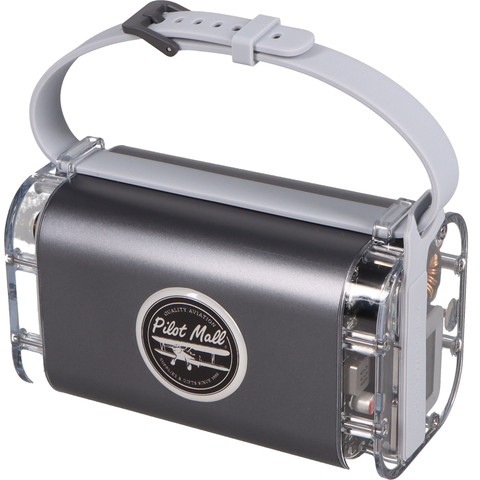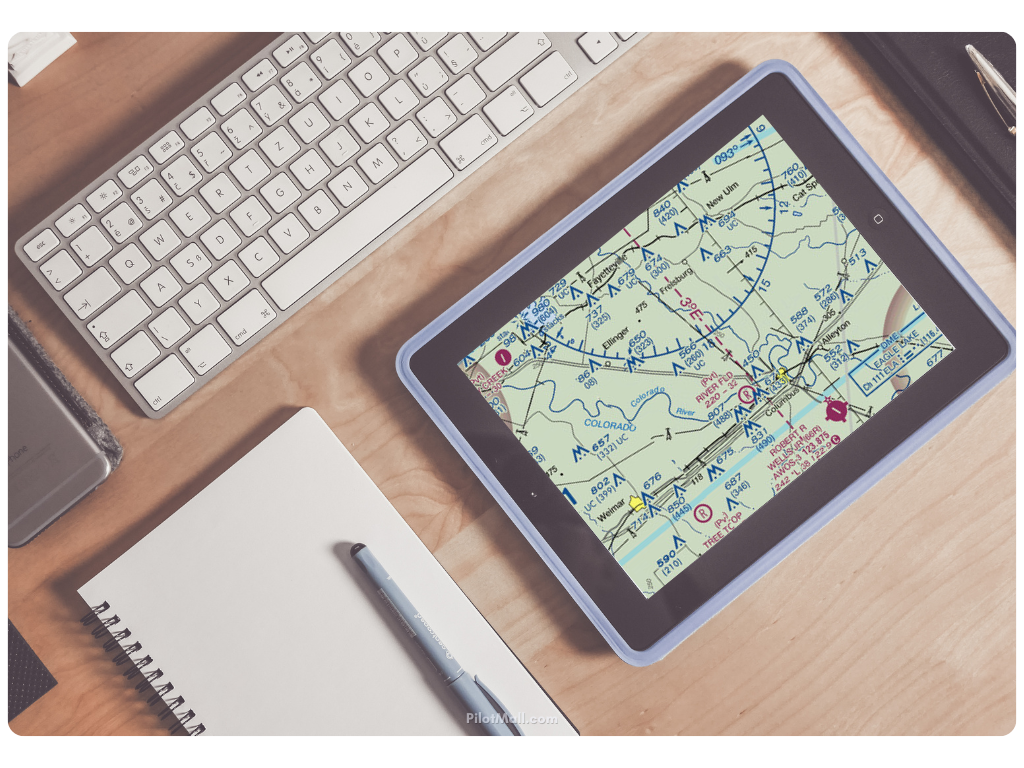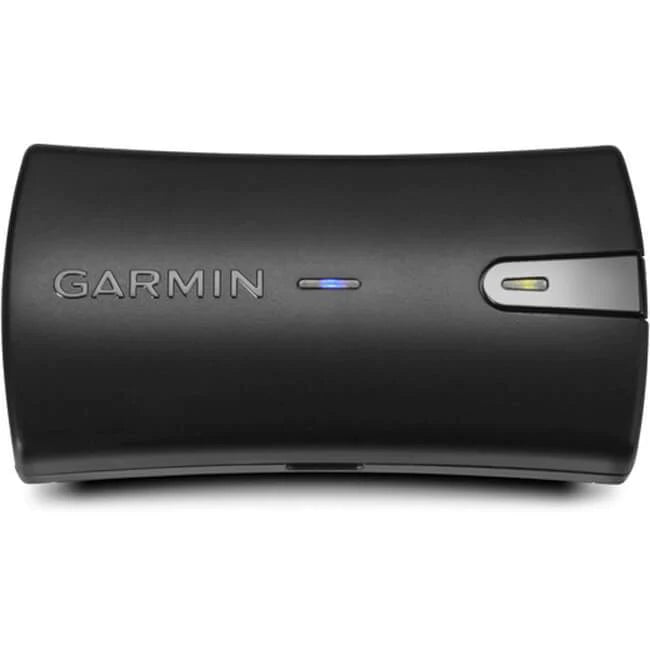10 Tips for Using an iPad in the Cockpit
In our world of increasingly digital cockpits, the iPad is a useful tool for both professional and general aviation pilots. Gone are the days of flipping through multiple paper sectionals on a long cross-country flight. Many pilots have embraced the Apple iPad, iPad mini, or another tablet device in lieu of paper charts for flight planning, in-flight navigation and more.

 In our world of increasingly digital cockpits, the iPad is a useful tool for both professional and general aviation pilots. Gone are the days of flipping through multiple paper sectionals on a long cross-country flight.
In our world of increasingly digital cockpits, the iPad is a useful tool for both professional and general aviation pilots. Gone are the days of flipping through multiple paper sectionals on a long cross-country flight.
Many pilots have embraced the Apple iPad, iPad mini, or another tablet device in lieu of paper charts for flight planning, in-flight navigation and more.
Once you buy your new device and are ready to put it to use, here are some tips for things you can do to get started and maximize the benefits of flying with an iPad in the cockpit.
Let's get into it!
Start with a fully charged battery
If you are using an electronic flight bag (EFB), your iPad is integral to your safety. The battery must last throughout the entire flight so you can continue to use ForeFlight and other digital aviation apps.
The good news is that a fully charged iPad battery is designed to last 4 to 6 hours with continuous use, so simply ensure the battery is fully charged prior to takeoff.
Extend battery life
To get the most out of each battery charge, close any unnecessary apps running in the background. Disable Wi-Fi, cellular data, and Bluetooth if you will not need to use them once in the air. Depending on conditions, you may be able to adjust the screen brightness down as well if doing so is safe and does not interfere with your ability to view the screen.
Extend battery life even further by following Apple's recommended tips to maximize the life of your iPad battery. When storing your iPad for an extended period (a month or more), charge it to 50 percent rather than leaving it either fully charged or fully depleted.
A battery that has been stored in a fully discharged state may lose its ability to retain a full charge in the future. If your iPad battery is unable to hold 80 percent or more of its original capacity, contact Apple for iPad service and repair.
Pack one or more external power sources
A charged iPad battery is important, but so is a backup plan in case something goes wrong and your flight lasts longer than your battery charge (think weather delays or diversions).
Always bring at least one additional means of keeping your iPad charged in flight. The military has a saying that "two is one, and one is none." In this case, the premise is that you should assume one power source will fail, so having two is the equivalent of having one. For this reason, pro pilots relying on their iPad may opt for more than one external power source to supplement the internal iPad battery.
Your secondary power source can be a 12-volt charger or a stand-alone power pack device. For 12-volt chargers, we like the MyGoFlight Dual Digital USB Charger. For an amazing battery pack that suits all your electronic device needs we recommend The Beast Super Power Bank.

|
The Beast Super Power BankPhone? No Problem! Tablet? The Beast Super Power Bank can handle multiple! 40,000mAh Capacity: This juggernaut of a power bank ensures you have an abundant reserve of energy for all your in-cockpit devices. 100W Fast Charging: No more waiting around; get back to your flight faster. |
Do a pre-flight iPad check
You have a pre-flight checklist for your aircraft, and pilots who enjoy flying with an iPad should also always use a pre-flight checklist for their digital device. Include system checks and battery condition checks.
Open and run ForeFlight and other popular apps to ensure they function as expected. This device check allows you to confirm that your iPad is operating normally and can be reasonably expected to meet your needs while in the air.
 Download all charts prior to takeoff
Download all charts prior to takeoff
During your pre-flight check, confirm that all charts are current. Download up-to-date versions of every navigation chart you need or may potentially need for the duration of your flight.
Ensure your device has plenty of storage space available to hold your charts and to run your apps. Once you download and save each chart, confirm that it loads correctly with Wi-Fi and cellular data connection functions disabled.

Pro Tip: Disable the auto-update feature on your apps before you do your final chart check. This will prevent the potential of an app update glitch corrupting your chart database.
If you want to know all the different aviation apps you can use on your iPad we created a guide.
Secure iPad using cockpit mount
One of the first questions pilot need to answer when they decide to use the iPad while flying is, "Where should I mount my iPad in the cockpit?" The answer will vary based on pilot preference and cockpit configuration, but no matter what airplane you are flying, the iPad needs to be secured in some fashion. It should not simply be left loose where it can float around the cockpit and potentially slide out of reach or get damaged.
iPads can be secured using a yoke mount which clamps onto the yoke and places the device within easy view of the pilot.

Pro tip: This method works best with the iPad mini as its smaller size is less likely to block the view of the instrument panel.
Another method is to use a suction cup mount to secure your iPad to the side window. The suction cup mount is easily removable, making it a popular choice for pilots who are renting their aircraft or flying multiple different aircraft.
The third option for securing your iPad or iPad mini in the cockpit is a kneeboard. The kneeboard approach is popular with pilots who want to keep their iPad nearby without it obstructing either their instrument panel or view out the window during flight.
Protect your iPad from overheating
One of the most common iPad problems for pilots is the issue of overheating. New pilots wonder, "How do I keep my iPad cool in a cockpit?" Like your phone and other electronic devices, your iPad will naturally generate heat with use.
The iPad is designed to operate within an internal temperature range of 32 to 95 degrees Fahrenheit. For the iPad, too hot is worse than too cold. In a too cold situation, the iPad will simply lag slightly during use until it naturally warms up.
On the other hand, if the internal temperature is above the operational range, the iPad will display a temperature warning, then initiate an automatic system shutdown to protect itself.
If this happens while you are in the air, you will need to quickly switch over to a backup device like an iPad mini, a tablet, your phone, or paper charts. If you were using your iPad for weather and other alerts, you will need a secondary means of receiving that information as well. Overheating your iPad creates additional strain on the battery and can shorten its overall lifespan.
Be proactive and keep your iPad running within its optimal range by avoiding leaving it in a hot vehicle or sweltering cockpit. When you choose a mounting location in the cockpit, think about the position of the sun and plan accordingly.
If the black iPad screen is exposed to direct sunlight, it absorbs a lot of heat and the temperature can increase quickly. Remain vigilant to this as you fly and continue to keep the iPad out of direct sunlight as much as possible, repositioning it if necessary when you adjust course.
A RAM mount can help with this as it lets you easily pivot the iPad screen away from the sun without needing to completely remove and remount the iPad.
In warm conditions, proper airflow helps keep your iPad from overheating, so you may need to temporarily remove the standard case or purchase a cooling case to use instead. An iPad cooling case that works with both kneeboard and mounted configurations is a useful way to help prevent your iPad from overheating even on the hottest of days.
Charging generates internal heat as well. This is another reason to fully charge your iPad prior to takeoff so the battery can last the entire time you are in the air without needing to be plugged in.
Pair your iPad with an external GPS
While you are flying, if you are using a WiFi iPad, your iPad will need a connection with an external GPS. Unlike standard iPads and iPad minis, a WiFi iPad has no internal GPS.
It instead relies solely upon connection to an external GPS to provide location data. This allows the WiFi iPad to establish your position and feed that information to Foreflight or any other app that needs the data for navigation or weather purposes.
Standard iPads and iPad minis with cellular data may not strictly need an external GPS, but it is still a good idea to use one. The external GPS offers improved position data reliability.
While integrated GPS functionality is known to cut out from time to time such as when toggling between apps or if the screen goes to sleep, those hiccups are eliminated with a dedicated GPS unit like the Garmin GLO 2 that is compatible not only with Apple, but also with Android as well.
Confirm that you are using the iPad within FAA guidelines
If you choose to switch over to an Electronic Flight Bag (EFB) cockpit, review the applicable FARs and ACs to confirm you are legal and compliant. For most general aviation pilots, using an iPad falls within the FAA parameters as a replacement for paper charts provided you keep your digital charts up to date.
Avoid common iPad mistakes
Even after you have learned to keep your iPad out of the sun, to always secure it in the cockpit, and to do a pre-flight check, you can still fall prey to other common iPad mistakes.
Distracted driving is dangerous and so is distracted flying. A pilot who is too focused on a tablet screen can lose situational awareness. Remind yourself to continue looking outside for traffic, especially during your approach to landing and in congested airspace.
Learn and become proficient with using your equipment. The more comfortable you are using your iPad, the easier it will be to incorporate it into flying.
When you purchase an iPad, the next step is to spend extra time on the ground watching training videos about the different apps that you will be using. Several hours invested in mastering apps on the ground can save you time and frustration in the air.
Ready to get started and outfit your electronic cockpit? Shop our selection of all the best tablet accessories for pilots.
Enjoyed our 10 tips?
Check out other useful guides!
-
12 Pilot Flight Bag Essentials You Should Always Be Carrying
-
20 Best Aviation Watches You Can Buy Right Now [For Every Budget]
Did you find this article helpful?
Do you think we missed anything important? Let us know in the comments below!


























